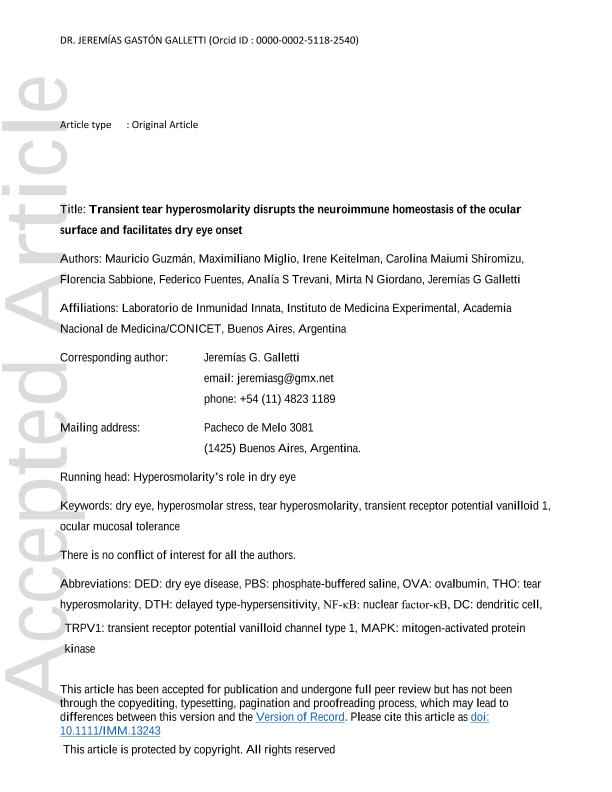Artículo
Transient tear hyperosmolarity disrupts the neuroimmune homeostasis of the ocular surface and facilitates dry eye onset
Guzmán Fonseca, Oscar Mauricio ; Miglio Rodríguez, Maximiliano Sebastian
; Miglio Rodríguez, Maximiliano Sebastian ; Keitelman, Irene Angélica
; Keitelman, Irene Angélica ; Shiromizu, Carolina Maiumi; Sabbione, Florencia
; Shiromizu, Carolina Maiumi; Sabbione, Florencia ; Fuentes, Federico
; Fuentes, Federico ; Trevani, Analía Silvina
; Trevani, Analía Silvina ; Giordano, Mirta Nilda
; Giordano, Mirta Nilda ; Galletti, Jeremías Gastón
; Galletti, Jeremías Gastón
 ; Miglio Rodríguez, Maximiliano Sebastian
; Miglio Rodríguez, Maximiliano Sebastian ; Keitelman, Irene Angélica
; Keitelman, Irene Angélica ; Shiromizu, Carolina Maiumi; Sabbione, Florencia
; Shiromizu, Carolina Maiumi; Sabbione, Florencia ; Fuentes, Federico
; Fuentes, Federico ; Trevani, Analía Silvina
; Trevani, Analía Silvina ; Giordano, Mirta Nilda
; Giordano, Mirta Nilda ; Galletti, Jeremías Gastón
; Galletti, Jeremías Gastón
Fecha de publicación:
10/2020
Editorial:
Wiley Blackwell Publishing, Inc
Revista:
Immunology
ISSN:
0019-2805
Idioma:
Inglés
Tipo de recurso:
Artículo publicado
Clasificación temática:
Resumen
Dry eye disease (DED) is a highly prevalent ocular surface disorder with neuroimmune pathophysiology. Tear hyperosmolarity (THO), a frequent finding in affected patients, is considered a key element in DED pathogenesis, yet existing animal models are based on subjecting the ocular surface to the more complex desiccating stress − decreased tear production and/or increased evaporation − instead of strict hyperosmolar stress. Here we characterized a murine model of THO that does not involve desiccating stress, thus allowing us to dissect the contribution of THO to DED. Our results showed that THO is sufficient to disrupt neuroimmune homeostasis of the ocular surface in mice, and thus reproduce many sub‐clinical DED findings. THO activated nuclear factor‐κB signalling in conjunctival epithelial cells and increased dendritic cell recruitment and maturation, leading to more activated (CD69+) and memory (CD62lo CD44hi) CD4+ T‐cells in the eye‐draining lymph nodes. Ultimately, THO impaired the development of ocular mucosal tolerance to a topical surrogate antigen in a chain of events that included epithelial nuclear factor‐κB signalling and activation of transient receptor potential vanilloid 1 as the probable hypertonicity sensor. Also, THO reduced the density of corneal intraepithelial nerves and terminals, and sensitized the ocular surface to hypertonicity. Finally, the adoptive transfer of T‐cells from THO mice to naïve recipients under mild desiccating stress favoured DED development, showing that THO is enough to trigger an actual pathogenic T‐cell response. Our results altogether demonstrate that THO is a critical initiating factor in DED development.
Archivos asociados
Licencia
Identificadores
Colecciones
Articulos(IMEX)
Articulos de INST.DE MEDICINA EXPERIMENTAL
Articulos de INST.DE MEDICINA EXPERIMENTAL
Citación
Guzmán Fonseca, Oscar Mauricio; Miglio Rodríguez, Maximiliano Sebastian; Keitelman, Irene Angélica; Shiromizu, Carolina Maiumi; Sabbione, Florencia; et al.; Transient tear hyperosmolarity disrupts the neuroimmune homeostasis of the ocular surface and facilitates dry eye onset; Wiley Blackwell Publishing, Inc; Immunology; 161; 2; 10-2020; 148-161
Compartir
Altmétricas



